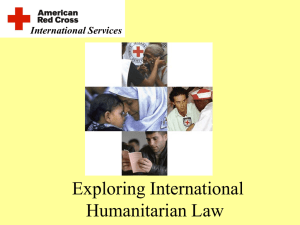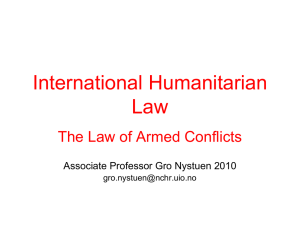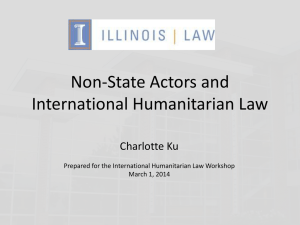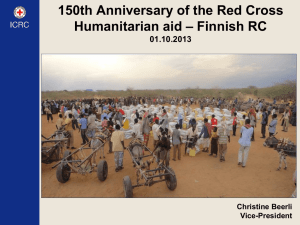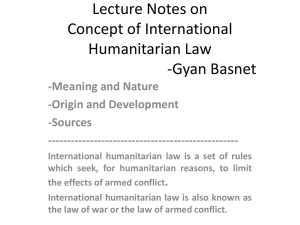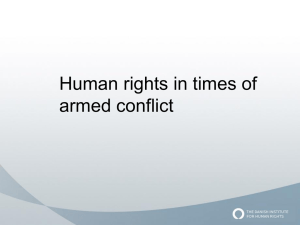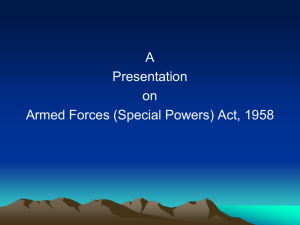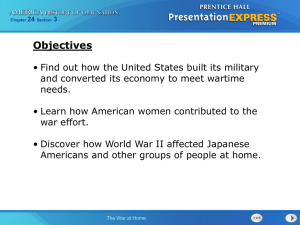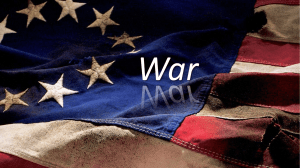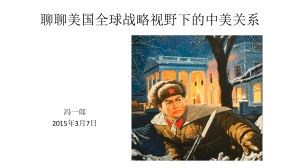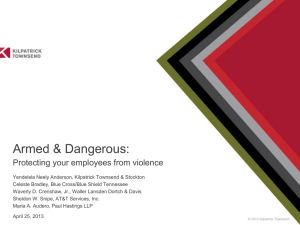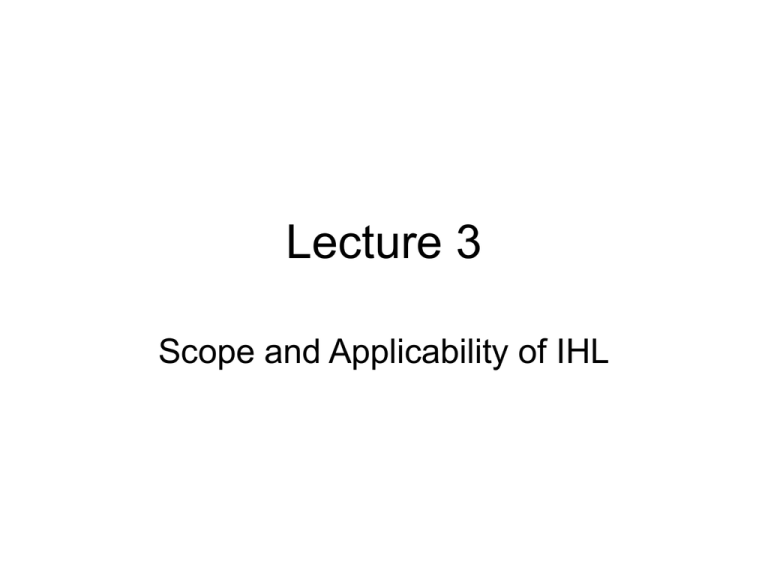
Lecture 3
Scope and Applicability of IHL
Scope of application
• PERSONAL scope of application (To
which subjects does IHL apply?)
• MATERIAL scope of application (In which
situations do IHL apply?)
Personal scope of application:
• To which subjects do IHL apply?
– States (parties to the conflict and to IHL
instruments)
– Non-state armed groups (parties to the
conflict)
– Individuals (belonging to parties to the
conflict):
• Civilians and other protected persons (soldiers
hors de combat) (have rights and obligations)
• Combatants (have rights and obligations)
Material scope of application
1) International armed conflict and occupation
2) Non-international armed conflicts:
2.1) Wars of national liberation
2.2) Civil war
2.3) Other non-international armed conflicts
3) Internal disturbances
4) Peace
1. International conflicts and
occupation
• IHL applies in international armed conflict
or during occupation
• What is an international armed conflict?
– When the armed forces of one state uses
armed force against another state
• What is occupation?
– When the armed forces of one state occupies
territory outside its own territory
Common Article 2, GC
• In addition to the provisions which shall be implemented
in peacetime, the present Convention shall apply to all
cases of declared war or of any other armed conflict
which may arise between two or more of the High
Contracting Parties, even if the state of war is not
recognized by one of them.
The Convention shall also apply to all cases of partial or
total occupation of the territory of a High Contracting
Party, even if the said occupation meets with no armed
resistance.
Common Art.2, para 3, GC
• Although one of the Powers in conflict may not be a
party to the present Convention, the Powers who are
parties thereto shall remain bound by it in their mutual
relations. They shall furthermore be bound by the
Convention in relation to the said Power, if the latter
accepts and applies the provisions thereof.
Application of IHL is not dependent
on mutual State Party recognition
• Article 13, GCI : The present Convention shall
apply to the wounded and sick belonging to the
following categories:
…….
(3) Members of regular armed forces who
profess allegiance to a Government or an
authority not recognized by the Detaining Power.
2. Non-international armed conflict
• IHL applies, to a certain extent, in noninternational armed conflicts
– When there is a situation in a state that
amounts to an armed conflict, IHL applies
• What is a non-international armed conflict?
The Martens Clause
• Hague Convention IV: “Convention (IV)
respecting the Laws and Customs of
War on Land and its annex:
Regulations concerning the Laws and
Customs of War on Land”. The Hague,
18 October 1907.
(Compendium page 293)
The Martens Clause:
• “Until a more complete code of the laws of
war has been issued, the High Contracting
Parties deem it expedient to declare that, in
cases not included in the Regulations adopted
by them, the inhabitants and the belligerents
remain under the protection and the rule of the
principles of the law of nations, as they result
from the usages established among civilized
peoples, from the laws of humanity, and the
dictates of the public conscience”.
Non-International Armed Conflicts
(NIAC)
2.1 Wars of national liberation etc.
2.2 Civil war
2.3 Other non-international armed
conflicts
2.1. Wars of national liberation
• Additional Protocol 1 to the Geneva
Conventions makes IHL applicable to
certain non-international armed conflicts:
Wars against colonial domination, racist
regimes etc.
Article 1, AP I:
2. In cases not covered by this Protocol or by
other international agreements, civilians and
combatants remain under the protection and
authority of the principles of international law
derived from established custom, from the
principles of humanity and from the dictates of
public conscience.
3. This Protocol, which supplements the Geneva
Conventions of 12 August 1949 for the
protection of war victims, shall apply in the
situations referred to in Article 2 common to
those Conventions.
Article 1(4) , AP I
4. The situations referred to in the preceding
paragraph include armed conflicts in which
peoples are fighting against colonial domination
and alien occupation and against racist régimes
in the exercise of their right of self-determination,
as enshrined in the Charter of the United
Nations and the Declaration on Principles of
International Law concerning Friendly Relations
and Co-operation among States in accordance
with the Charter of the United Nations.
• Art. 96 (3), AP I: The authority representing a
people engaged against a High Contracting
Party in an armed conflict of the type referred to
in Article 1, paragraph 4, may undertake to apply
the Conventions and this Protocol in relation to
that conflict by means of a unilateral declaration
addressed to the depositary. Such declaration
shall, upon its receipt by the depositary, have in
relation to that conflict the following effects:
(a) the Conventions and this Protocol are
brought into force for the said authority as a
Party to the conflict with immediate effect;
(b) the said authority assumes the same rights
and obligations as those which have been
assumed by a High Contracting Party to the
Conventions and this Protocol;
2.2. Civil war
• Civil war is a war between the state
authorities of a state and an organized
armed group with control over parts of the
state territory
• Civil war is a non-international armed
conflict
Article 1, AP II
• 1. This Protocol, which develops and
supplements Article 3 common to the
Geneva Conventions of 12 August 1949
without modifying its existing conditions of
application, shall apply to all armed
conflicts which are not covered by Article 1
of the Protocol Additional to the Geneva
Conventions of 12 August 1949, and
relating to the Protection of Victims of
International Armed Conflicts (Protocol I)..
..and which take place in the territory of a
High Contracting Party between its
armed forces and dissident armed
forces or other organized armed
groups which, under responsible
command, exercise such control over a
part of its territory as to enable them to
carry out sustained and concerted
military operations and to implement this
Protocol.
2.3. Other non-international armed
conflicts
• Non-international armed conflict which do
not reach the threshold of:
– AP I, Article 1 (4): peoples fighting colonial
domination etc.
– AP II, Article 1: civil war between state military
forces and organised armed forces in the
territory of the state
Common Article 3, GC:
• In the case of armed conflict not of an
international character occurring in
the territory of one of the High
Contracting Parties, each Party to the
conflict shall be bound to apply, as a
minimum, the following provisions:
Common Article 3, GC
• (1) Persons taking no active part in the
hostilities, including members of armed
forces who have laid down their arms and
those placed ' hors de combat ' by
sickness, wounds, detention, or any other
cause, shall in all circumstances be
treated humanely, without any adverse
distinction founded on race, colour, religion
or faith, sex, birth or wealth, or any other
similar criteria.
Common Article 3, GC
• To this end, the following acts are and shall remain
prohibited at any time and in any place whatsoever with
respect to the above-mentioned persons:
(a) violence to life and person, in particular murder of all
kinds, mutilation, cruel treatment and torture;
(b) taking of hostages;
(c) outrages upon personal dignity, in particular
humiliating and degrading treatment;
(d) the passing of sentences and the carrying out of
executions without previous judgment pronounced by a
regularly constituted court, affording all the judicial
guarantees which are recognized as indispensable by
civilized peoples.
(2) The wounded and sick shall be collected and cared
for.
3. Internal disturbances
• IHL does not apply:
• Article 1, AP II:
• 2. This Protocol shall not apply to
situations of internal disturbances and
tensions, such as riots, isolated and
sporadic acts of violence and other acts
of a similar nature, as not being armed
conflicts.
4. Peace
• IHL does not apply
• (with certain exceptions regarding the use
of the Red Cross/Red Crescent emblem,
placement of military buildings etc.)
De facto situations
Applicability of IHL:
1. INTERNATIONAL ARMED CONFLICT PLUS
OCCUPATION
GC Common Art. 2 + AP I,
Art.1
2. NON-INTERNATIONAL ARMED CONFLICT:
2.1 Wars of national liberation
AP I, Art.1 +
GC Common Art. 2
2.2. Non-international armed conflict (Civil war)
between the state and organized group with territorial control
AP II Art.1
2.3. Other non-international armed conflict
between the state and groups or between groups
GC Common Art. 3
3.Disturbances
Riots/Unrest
Disasters
Others causes for state of emergency
Not IHL
4. Peace
Not IHL
Qualification of situations
• Never assume that any substantive IHL
rule applies before having made the
determination of what kind of situation you
are dealing with.
• If in doubt about how to categorize the
situation, always assume that the regime
giving the most protection is applicable,
(and explain why you do this).
Article 8 of the ICC statute:
• War crimes: violations of IHL
• Lists the different situations:
– Art.8 (2) (a) and (b): IAC
– Art.8 (2) (c) and (e) (f): NIAC
Qualify the following situations:
• The invasion of in Iraq 1991
• The situation in Bosnia 1992-1995
• The situation in Kosovo spring/summer
1999
• The situation in Iraq 2003
• The situation in Iraq 2007

